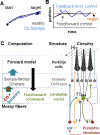Corollary Discharge Signals in the Cerebellum
- PMID: 31230918
- PMCID: PMC6733673
- DOI: 10.1016/j.bpsc.2019.04.010
Corollary Discharge Signals in the Cerebellum
Abstract
The cerebellum is known to make movements fast, smooth, and accurate. Many hypotheses emphasize the role of the cerebellum in computing learned predictions important for sensorimotor calibration and feedforward control of movements. Hypotheses of the computations performed by the cerebellum in service of motor control borrow heavily from control systems theory, with models that frequently invoke copies of motor commands, called corollary discharge. This review describes evidence for corollary discharge inputs to the cerebellum and highlights the hypothesized roles for this information in cerebellar motor-related computations. Insights into the role of corollary discharge in motor control, described here, are intended to inform the exciting but still untested roles of corollary discharge in cognition, perception, and thought control relevant in psychiatric disorders.
Keywords: Cerebellar; Corollary discharge; Efference copy; Mossy fibers; Motor control; Reafference.
Copyright © 2019 Society of Biological Psychiatry. Published by Elsevier Inc. All rights reserved.
Figures

References
-
- Miall RC, Weir DJ, Wolpert DM, and Stein JF, “Is the cerebellum a smith predictor?,” J. Mot. Behav, vol. 25, no. 3, pp. 203–216, September 1993. - PubMed
-
- Holmes G, “The Croonian Lectures On The Clinical Symptoms Of Cerebellar Disease And Their Interpretation. Lecture I. 1922,” Cerebellum Lond. Engl, vol. 6, no. 2, pp. 142–147; discussion 141, 2007. - PubMed
-
- Ohyama T, Nores WL, Murphy M, and Mauk MD, “What the cerebellum computes,” Trends Neurosci, vol. 26, no. 4, pp. 222–227, April 2003. - PubMed
-
- Wolpert DM and Miall RC, “Forward Models for Physiological Motor Control,” Neural Netw. Off. J. Int. Neural Netw. Soc, vol. 9, no. 8, pp. 1265–1279, November 1996. - PubMed
Publication types
MeSH terms
Grants and funding
LinkOut - more resources
Full Text Sources

